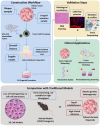Organoid technology in cervical cancer research
- PMID: 40520874
- PMCID: PMC12163444
- DOI: 10.62347/FNTD1712
Organoid technology in cervical cancer research
Abstract
Cervical cancer poses a serious threat to women's lives and health, and it may cause damage to the reproductive system, infertility, and even death. This study reviews the research progress of organoids in the treatment of cervical cancer. Studies have found that the culturing of tumor cell lines and the modeling techniques of tumor xenotransplantation for cervical cancer have certain limitations. Cervical cancer organoids are preclinical research models formed by culturing tumor cells derived from patients, which more accurately and effectively retain tumor heterogeneity, and also have the potential to take into account the interaction between tumor cells and the extracellular matrix. This article reviews the research on cervical cancer organoid models in the pathogenesis, drug screening, and precision medicine aspects in recent years, and then analyzes the development prospects and challenges of organoid technology in gynecological tumor research, in order to explore new possibilities for individualized treatment of cervical cancer.
Keywords: Organoid; cervical cancer; drug screening experiments; precision medicine; preclinical model.
AJCR Copyright © 2025.
Conflict of interest statement
None.
Figures


Similar articles
-
Advances in the application of colorectal cancer organoids in precision medicine.Front Oncol. 2024 Dec 3;14:1506606. doi: 10.3389/fonc.2024.1506606. eCollection 2024. Front Oncol. 2024. PMID: 39697234 Free PMC article. Review.
-
Deciphering the Tumor Microenvironment of Colorectal Cancer and Guiding Clinical Treatment With Patient-Derived Organoid Technology: Progress and Challenges.Technol Cancer Res Treat. 2024 Jan-Dec;23:15330338231221856. doi: 10.1177/15330338231221856. Technol Cancer Res Treat. 2024. PMID: 38225190 Free PMC article. Review.
-
Organoid modeling meets cancers of female reproductive tract.Cell Death Discov. 2024 Sep 27;10(1):410. doi: 10.1038/s41420-024-02186-x. Cell Death Discov. 2024. PMID: 39333482 Free PMC article. Review.
-
Organoid development and applications in gynecological cancers: the new stage of tumor treatment.J Nanobiotechnology. 2025 Jan 16;23(1):20. doi: 10.1186/s12951-024-03086-z. J Nanobiotechnology. 2025. PMID: 39819668 Free PMC article. Review.
-
Novel organoid model in drug screening: Past, present, and future.Liver Res. 2021 May 27;5(2):72-78. doi: 10.1016/j.livres.2021.05.003. eCollection 2021 Jun. Liver Res. 2021. PMID: 39959346 Free PMC article. Review.
References
-
- Alci A, Aytekin O, Ersak B, Kilic F, Oktar O, Caner C, Korkmaz V, Comert GK, Selcuk I, Toptas T, Boran N, Tasci T, Karalok A, Basaran D, Tekin OM, Ustun YE, Turan T, Ureyen I. The role of neoadjuvant chemotherapy before radical surgery in stage IB2/IIA2 squamous cell cervical cancers. BMC Womens Health. 2024;24:365. - PMC - PubMed
-
- Morse IM, Amiry J. A ‘smear campaign’ against patient-excluded policy changes: a reflection on the language used in cervical screening programmes. Br J Gen Pract. 2024;74(Suppl 1):bjgp24X738033. - PubMed
-
- Guo XM, Roman LD, Matsuo K. Considerations for route of hysterectomy in low-risk cervical cancer. Int J Gynecol Cancer. 2024;34:1481. - PubMed
Publication types
LinkOut - more resources
Full Text Sources
